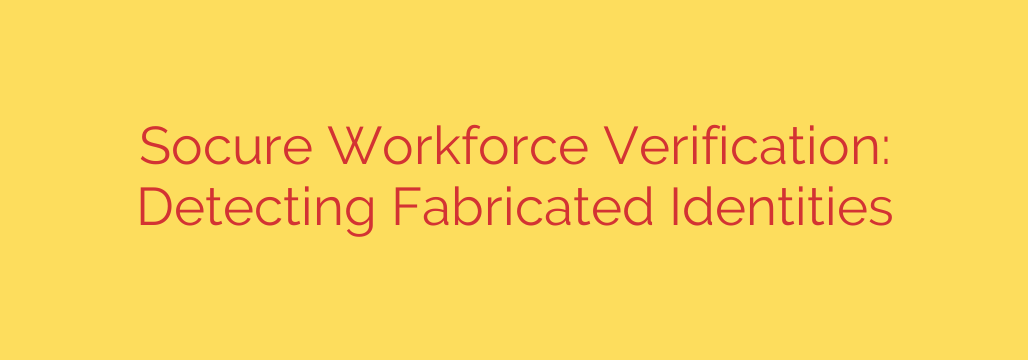
Beyond the Resume: How Fabricated Identities Are Infiltrating the Workforce
In today’s competitive hiring market, securing top talent is a major challenge. But a new, more sinister threat is emerging that goes far beyond a padded resume or an exaggerated skill set: the rise of the fabricated identity. Applicants are not just lying about their experience; they are applying for—and getting—jobs using entirely fake personas.
This isn’t standard identity theft where a criminal impersonates a real person. Instead, malicious actors are creating synthetic identities, which are carefully constructed, fictional personas built from a mix of real, stolen, and entirely made-up data. These “Frankenstein” identities are designed to look legitimate enough to pass cursory checks, creating a new class of high-risk “employees” who are, in reality, complete unknowns.
For businesses, the implications are severe. Hiring a phantom employee opens the door to a host of devastating security and financial risks.
Why Traditional Background Checks Are Falling Short
For decades, companies have relied on standard background checks to vet potential hires. These checks typically search for criminal records, verify past employment, and confirm educational credentials. However, they have a fundamental flaw when it comes to fabricated identities.
A traditional background check verifies information about a name you provide. But what if the name itself is fake? A clean background check on a fake person is dangerously misleading. Fabricated identities are designed to have no criminal history because the person doesn’t actually exist. They are clean slates, purpose-built to bypass legacy systems that aren’t designed to question the authenticity of the core identity itself.
As remote and hybrid work models become the norm, the risk is amplified. Without in-person interviews, it’s easier for an applicant using a fake identity to slip through the cracks, gaining network access and sensitive permissions from anywhere in the world.
The True Cost of a Phantom Employee
Allowing an individual with a fabricated identity into your organization is more than just a bad hire; it’s a critical security failure. The potential damage is extensive and multifaceted:
- Catastrophic Security Breaches: A fake employee granted system access becomes the ultimate insider threat. They can steal proprietary data, customer lists, intellectual property, and financial information without raising immediate suspicion.
- Direct Financial Fraud: One of the most common motives is payroll fraud. The “employee” collects a salary, and by the time the deception is discovered, they have vanished with thousands of dollars. They can also exploit internal systems to enable larger financial schemes.
- Compliance and Regulatory Violations: For industries governed by Know Your Customer (KYC) and Anti-Money Laundering (AML) regulations, hiring an unverified individual can lead to severe penalties and legal consequences.
- Reputational Damage: A data breach or major fraud incident traced back to a fake employee can permanently damage a company’s reputation and erode customer trust.
A Modern Defense: The Multi-Layered Approach to Identity Verification
To combat this sophisticated threat, businesses must evolve their hiring and onboarding processes. A modern workforce verification strategy moves beyond simply checking a name against a database and instead focuses on holistically validating that a person is who they claim to be.
The most effective solutions use a multi-layered, data-driven approach that correlates hundreds of digital and physical data points in real-time. Key components of a robust verification system include:
- Comprehensive Data Correlation: Instead of just one or two sources, this method cross-references an applicant’s name, address, phone number, email, and IP address against a vast network of authoritative data sources to check for consistency and legitimacy.
- Digital Footprint Analysis: A real person has a history. Advanced systems analyze an applicant’s digital identity—the age and usage of their email and phone number—to determine if it aligns with a real-world presence or looks like it was created yesterday.
- Advanced Document Verification: This involves using AI-powered technology to confirm that a government-issued ID (like a driver’s license or passport) is authentic and hasn’t been tampered with, often paired with a biometric selfie check to match the person to the document.
- Machine Learning and AI: Sophisticated algorithms are essential for detecting the subtle patterns and anomalies that signal a fabricated identity. AI can identify connections and risks that are invisible to the human eye, providing a powerful defense against fraud.
Actionable Steps to Secure Your Hiring Process
Protecting your organization from the threat of fabricated identities requires a proactive and security-first mindset.
- Integrate Identity Verification Early: Don’t wait until an offer is made. Implement robust identity verification at the beginning of the application process to weed out bad actors before they waste your team’s time and resources.
- Adopt a Zero-Trust Approach: Assume nothing. Every piece of information provided by an applicant should be subject to verification through trusted, independent technology.
- Educate Your HR and Security Teams: Ensure that everyone involved in hiring understands the nature of this threat and the red flags to look for, such as inconsistencies in application data or an unusual lack of a digital footprint.
- Leverage Modern Technology: Relying on manual reviews or outdated systems is no longer sufficient. Invest in a comprehensive identity verification platform that provides the multi-layered defense needed to stop today’s sophisticated fraudsters.
In the end, building a secure and trustworthy workforce starts with knowing, with a high degree of certainty, that your employees are real. By moving beyond the resume and embracing a modern approach to identity verification, you can protect your company’s assets, reputation, and future.
Source: https://www.helpnetsecurity.com/2025/07/17/socure-workforce-verification/








